Social commerce is here to stay – here’s how to use it effectively
In 2021, the global social commerce market was worth $492 billion. It is expected to reach $1.2 trillion by 2025 — nearly three times its current worth.
Traditionally when you think of eCommerce, you may picture your customers sitting down at their computers, browsing your site and pulling out their credit cards to make a purchase. (Or forgetting where their wallet is, going to search for it and getting distracted!)
In 2022, the reality can be very different. These days, your customers are more likely to be browsing your products using mobile devices or tablets. They may not be at home and they may not even be on your website. They could be scrolling your Instagram feed or downloading an app with your catalogue in it.
Instead of calling your customer service team when they have questions or issues, they are more likely to message your business’s Facebook page. Often, they’ll buy products directly through the social platform where they’re advertised.
The rise of social media has led to businesses investing more in their social presence and using these platforms to boost sales.
Later in this blog post, we’ll explore how social commerce works with your WooCommerce store and share tips for getting started. But first, here’s a detailed look at features of social commerce, including:
-
Storefronts on social profiles
-
Shoppable content
-
Live shopping and branded influencer content
-
A shop tab or feed
-
User-generated content
-
In-app messaging
Stay in the loop with industry trends
Subscribe to our newsletter for the latest industry news, insights and trends delivered straight to your inbox.
Features of social commerce
Social commerce can take many forms, involving:
- Increasing brand awareness through a combination of organic and paid social content
- Direct sales through shoppable content, so customers can purchase products in the app where they’re viewing them
- Chatbots providing product information or offering first-line support
- Live shopping events showing influencers using products that viewers can purchase while they’re watching the live stream
Most innovation is designed to contribute to a more seamless or engaging experience for the consumer. Much of the appeal of social commerce lies in the fact that it meets consumers where they are, instead of trying to redirect them to a third-party platform.
Customers can view a business’s social account, see their product range, ask questions about it and complete the purchase, all without ever having visited their website.
Storefronts on social profiles
In the early days of social media, companies used their social accounts to showcase products and raise brand awareness but users still had to go to a different website to complete a purchase.
As technology advances, brands are integrating more elements of their online stores into their social profiles so that their users can view their range without having to leave the app.
Luxury jeweller, David Morris, has this function on the brand’s Instagram account, which is linked to its WooCommerce site.
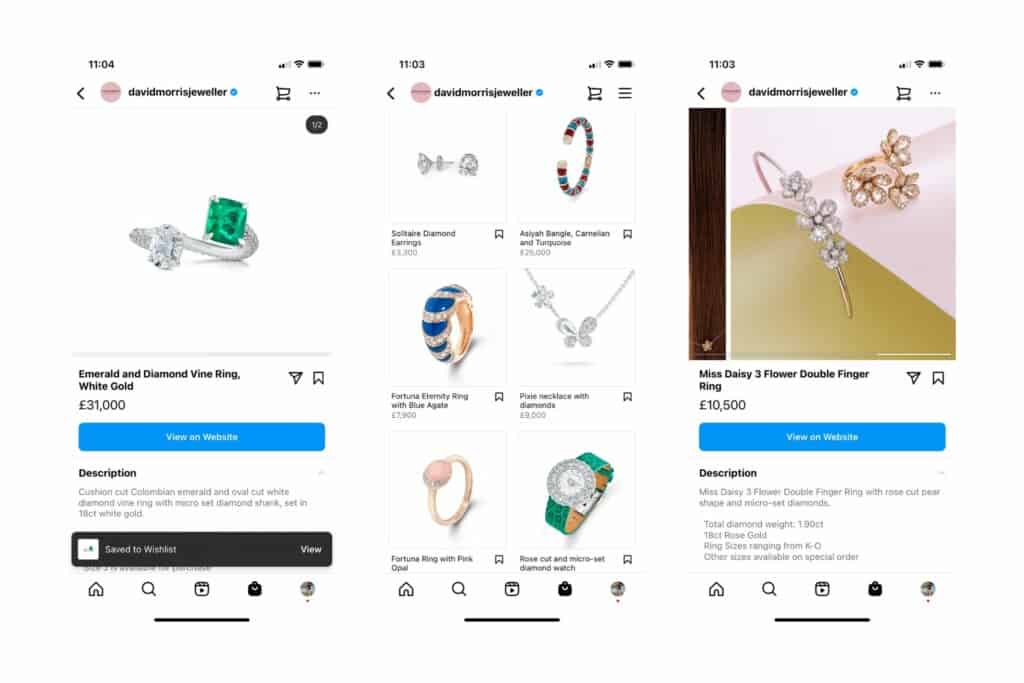
Instagram users can click ‘View Shop’ to browse the product range just like they would on a website. It also allows Instagram users to save their products to wish lists or collections, which can act as bookmarks for purchases later down the line.
Another good example comes from our client, Positive News — the first media organisation in the world dedicated to quality, independent reporting about what’s going right.
Through its Facebook shop, Positive News gives visitors to its page the option to purchase single issues, subscriptions, and gifts.
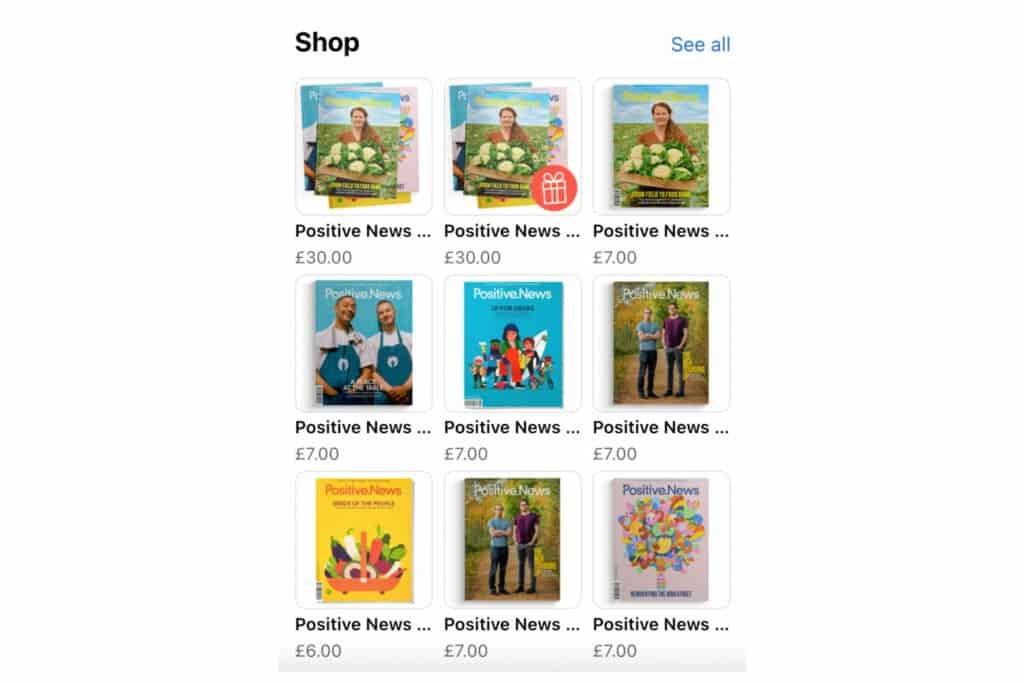
Shoppable content
More retailers are incorporating shoppable content into their social feeds. This could be in the form of organic posts or paid ads featuring clickable links to product pages within the app.
Users can purchase the products featured in social media posts without having to navigate to a different app or website, making for a more seamless transaction.
Our client, Pikt, is an organic fruit and veg box delivery service that has built shoppable content into its Instagram strategy. This links to the products sold through its WooCommerce store.
Pikt’s customers can either click ‘View Shop’ at the bottom of selected Instagram posts, or click on these posts to see navigate to further details of the individual products featured.
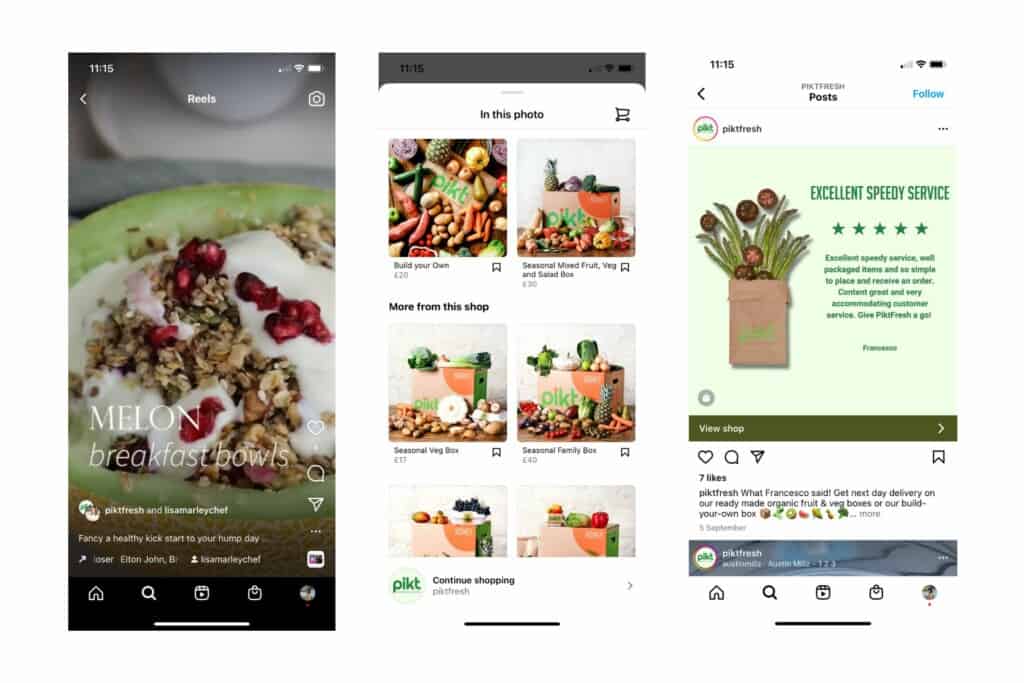
Live shopping and branded influencer content
Live shopping, where brands display products on social channels via live streams, is still a relatively niche area in the Western world. It’s currently extremely popular in China, where conversion rates on live shopping events can reach as high as 40%.
Not only does it allow brands to display product features in an engaging way, but it also provides an opportunity for influencer marketing.
Revenue from live shopping is projected to reach $11 billion in the US by the end of 2021 and nearly $25 billion by 2023, with companies such as Amazon, Facebook and YouTube investing heavily in this.
For instance, Amazon has been reaching out to high-profile TikTok stars offering them lucrative deals to encourage them to switch over to Amazon Live.
One reason why this type of social commerce is so popular is the opportunity for engagement.
This is evident within the beauty industry, where early adoption of social commerce follows the rise of influencers on Instagram and YouTube. Posting the likes of makeup tutorials and product reviews on these platforms has (and continues to) help influencers build significant followings.
Brands working with influencers can improve the visibility of their products, getting them in front of audiences who already trust the expertise of influencers they follow and are likely to make decisions based on their recommendations.
Don’t just take our word for it: A 2021 survey found that almost 70% of TikTok users have made a purchase after someone they knew posted about it online.
Supergreat is one brand that capitalises on this trend by providing a central point for reviews and influencer content. It shows users what other shoppers are buying, and encourages engagement with each other on live streams.
Supergreat also hosts live events to give users access to celebrities and brand founders. When TV personality Jonathan Van Ness hosted a live event on Supergreat promoting his hair care line, it resulted in one sale every minute!
Jacuzzi is another brand that incorporates influencers heavily in its marketing strategy.
The company’s Instagram accounts currently features Reels of various Olympic athletes such as Dame Kelly Holmes, Joe Fraser and Jessica-Jane Applegate talking about how the product fits into their lives. For example, unwinding after training or forming part of a pre-competition ritual.
Some of the content is repurposed for/from their podcast, which has multiple benefits:
- Driving more listeners to their podcast
- Making successful content go further and reach more people
- Ensuring content feels less like advertising to their audience by focusing on subjects other than products
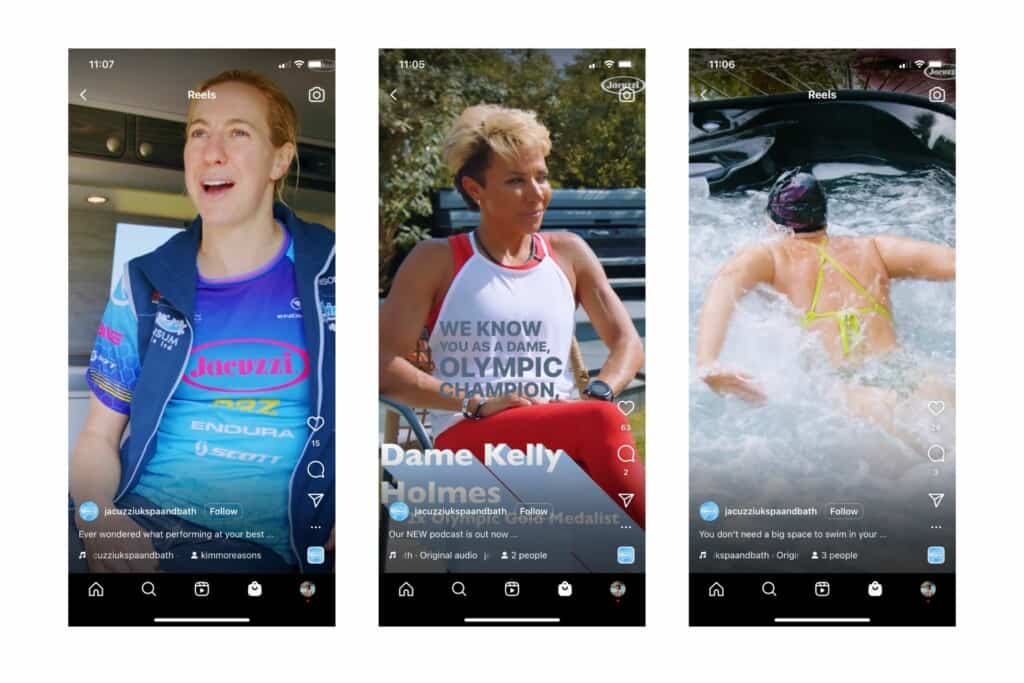
A shop tab or feed
Having a dedicated shopping tab or feed within an app can showcase different products that are tailored to a user’s interests based on previous posts they’ve interacted with.
Instagram and Pinterest both have this option available for consumers, who can scroll through an infinite feed of content until they find something they like.
Much like Instagram Collections, which allows users to save posts they they want to look at again later, Pinterest enables users to pin images of products to different wish lists or shopping lists, serving as inspiration for future purchases.
These shoppable product pins help users purchase the products in images by linking pins directly to the checkout page of an external website, creating a more streamlined purchase journey.
Despite Pinterest’s lack of significant growth in overall users, the number of users who engage with its shopping features has more than doubled year-on-year.
User-generated content
There is no doubt that influencer marketing can be effective. However, it isn’t always perceived as authentic.
A recent survey by Stakla found that only 10% of consumers considered influencer marketing authentic. Interestingly, what proved most popular was user-generated content (UGC), or content created by other consumers.
90% of consumers find UGC useful for making purchase decisions and believe what existing customers say about the brands over what brands say about themselves.
Netflix uses UGC a lot in its marketing strategies for movies and TV shows. By using hashtags of show titles, Netflix can build up anticipation ahead of new releases and get the word out about original content without having to invest heavily in marketing campaigns.
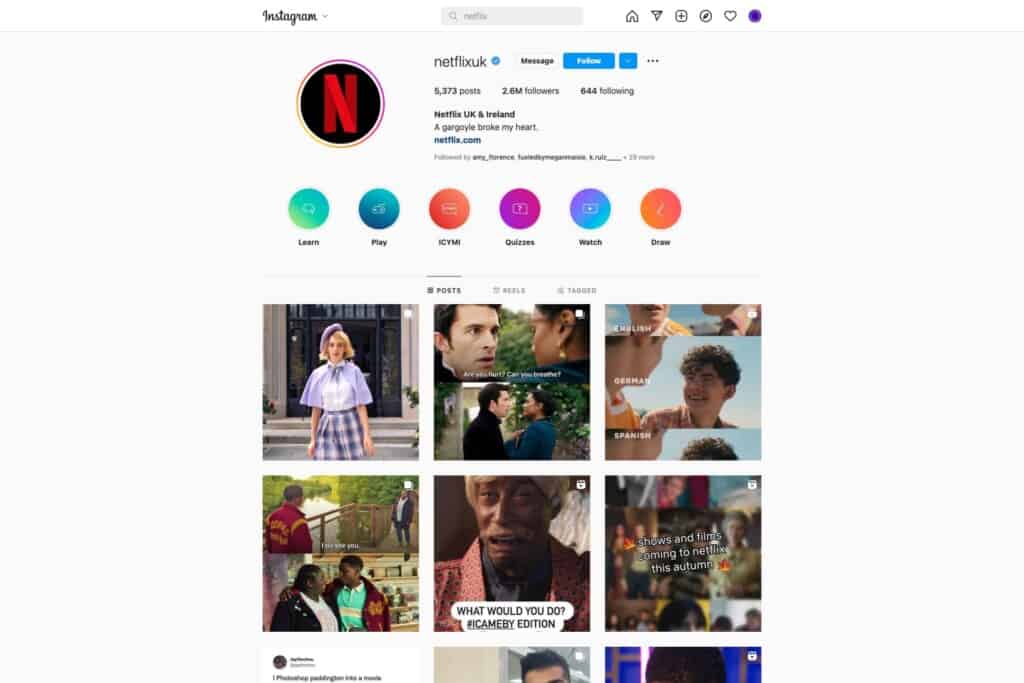
In-app messaging
If customers are browsing and shopping via social channels, then it stands to reason that they will also want to be able to ask questions and seek help with issues on these same channels. This is where conversational messaging comes in.
Conversational messaging is when a brand sets up in-app chat messages designed to follow typical lines of enquiry that their customers have. This can be done on Facebook Messenger, Instagram DMs and other messaging apps.
Our client, luxury chocolate retailer Elizabeth Shaw, has published a series of frequently asked questions on their Facebook page. Customers will either receive an automated response with links to further information, or a message saying a member of their team will get back to them.
This approach enables Elizabeth Shaw to respond to general customer enquiries in a way that is automated, freeing up their customer service staff to focus on more complex issues.
In-app messaging options are not just for larger brands. If you manage a small or medium-sized brand, having messaging on social platforms means your customers can get timely responses outside of business hours and lead to a better experience overall.
How social commerce works with your WooCommerce store
If your online store is built on WordPress and WooCommerce, there are a range of plugins you can use to integrate most major social media platforms.
WooCommerce connects with social platforms including Facebook, Instagram, Pinterest and TikTok that can be added and removed easily. This gives you the flexibility to test out different functions and find the solution that best fits your needs — and gets the best results with your target audience.
A key consideration when setting this up is ensuring that your social accounts are integrated with your order fulfilment and stock systems.
Let’s talk
Connect to continue the conversation, so you can boost sales and streamline processes for your online store.
Takeaways
Social commerce is seeing rapid growth across many sectors and is showing no signs of slowing down.
Brands that are able to sell and communicate consistently across multiple platforms will see this reflected in their bottom line, because seamless shopping experiences create happy (and repeat) customers.
- Social commerce is about bringing your products to your customer base
- Integrating your online store with your social accounts makes for a more seamless user journey
- Live shopping and influencer-branded content are likely to grow in popularity in 2022 and beyond
- User-generated content is a great way to build trust in your brand and convey authenticity
Tips for getting started
- Identify the best platform(s) for your business and audience
- Think about your customers and their wants and needs
- Integrate your social accounts with online store and back-end processes
- Use analytics to see what content performs best
- Adjust your strategy accordingly
We’re experts with WooCommerce
As certified WooExperts, Atomic Smash is officially endorsed by WooCommerce. We can help you get the most out of the platform.